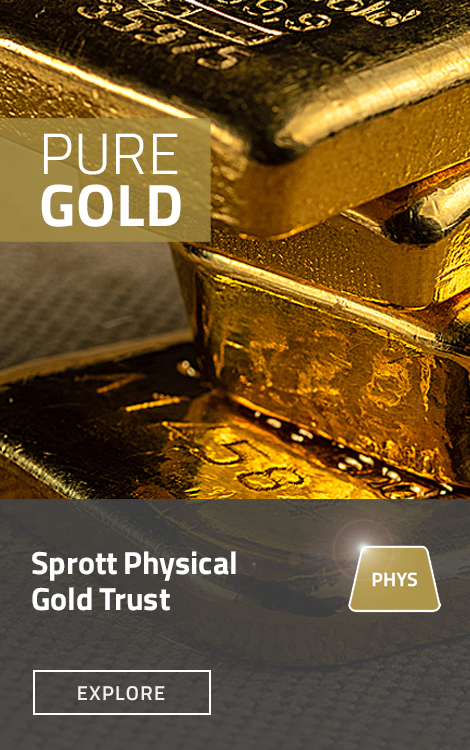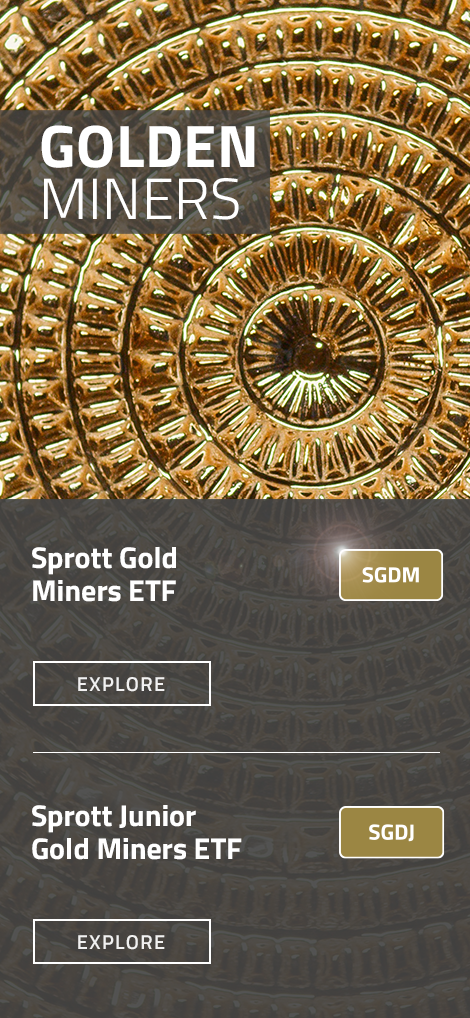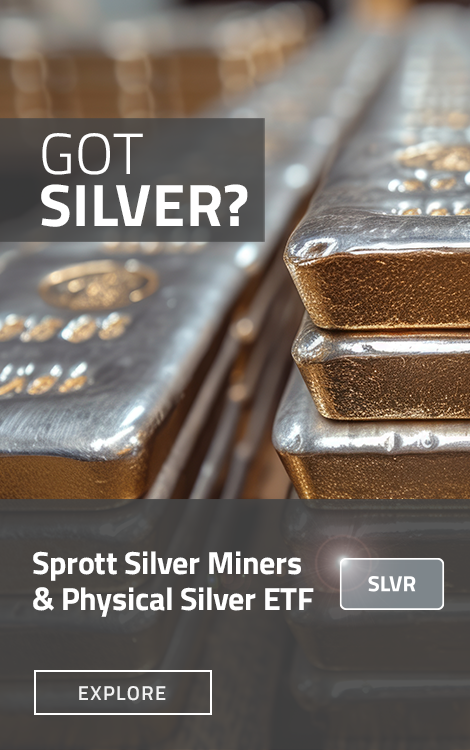Sprott CIO Maria Smirnova and Rick Rule discuss key drivers for gold and silver in 2025. They emphasize central bank buying, Eastern demand and the erosion of purchasing power as major factors for gold. For silver, industrial demand, particularly from solar and EVs, is crucial.
Video Transcript
Jesse Day: Hello, everybody. Thank you so much for attending this panel today. It's been a great VRIC so far, and I'm very excited to welcome Rick Rule and Maria Smirnova. We're going to discuss the precious metals sector in depth. Why don't we start with a quick introduction from each of you for those unfamiliar? Rick, we'll start with you.
Rick Rule: Rick Rule, 70-something years old, 50 years in the business, starting out here in Vancouver, among other things with Jay Martin's father, Joe Martin. Delighted to be here. Former colleague of Maria Smirnova. I tried to retire. I failed at that, but she's still at Sprott, so I'm delighted to be on a panel with her.
For those who don't know her, she is a high-quality, hard-working, sober analyst. She had to work with and for Peter Grosskopf, Rick Rule and Eric Sprott, which I think says a lot about her courage and tenacity.
Maria Smirnova: Rick, this was supposed to be about you, not me. Maria Smirnova. I've been with Sprott Inc., but Sprott Asset Management for about 20 years. I'm a portfolio manager working on our active equity side. I'm also the CIO, but that's a minor detail.
Jesse Day: Excellent. Let's dive into the current macro setup for gold and silver. I want to start with gold because we hear much about the main catalyst driving gold: central bank buying, retail participation in the East, and debt and deficits. I'm wondering what your thoughts are on what has driven the gold price to all-time highs in 2024 and maybe some things that people aren't paying attention to when it comes to the catalysts they should be. Maria, I'll start with you.
Maria Smirnova: Obviously, gold has multiple drivers. But last year, we talked a lot about the central bank buying. You've heard this in other panels at this conference. Yesterday, specifically, I heard that talked about. Then, the other part would be demand from the East, such as India and China, specifically, but other emerging economies, too.
In conclusion, these economies and governments are trying to protect their balance sheets from fiat currency devaluation, just like we do as investors. They're trying to diversify away from U.S. dollars in their foreign exchange reserves. We use terms like weaponization of the dollar.
When Russia went to war in Ukraine in 2022, and the West froze Russia's foreign exchange reserves, that was a signal to other countries to say, "Hey, I don't want that to happen to me." That's exactly when we started seeing a big pickup in central bank buying.
That trend continued to remain strong—from 2022 until last year and probably now. However, retail demand has also been strong, particularly in the East. It's been strong not just in gold—we'll talk about silver separately—but also in silver.
Jesse Day: Excellent. Rick, what catalysts brought us to all-time highs in 2024? Are we in the early stages of a longer-term precious metals bull market?
Rick Rule: I'm going to push back on all-time highs. All-time highs in nominal value. The difference between nominal value and purchasing power is what gold is all about. When people talk about $2,700 in a nominal value, they're talking about a floating abstraction for the denominator, and that's not right. I think it's important to recognize that.
Gold has done well throughout history, at least in my reading of history and also in my life, which is long enough that it's becoming history. I've seen that gold does very well when investors and savers are concerned about maintaining their purchasing power in fiat instruments.
If you believe the U.S. government statistics—I'm a voter, I don't—they will tell you that the destruction of your purchasing power in U.S. dollars is 2.6% compounded yearly. If there are any Americans in the audience, aside from me, if you look back at the basket of goods and services you've consumed from 2020 to 2025, this 2.6 number is fiction. I would suggest that the consumer price index (CPI) is the CPI-lie.
Look at your health insurance, health costs, rent, mortgage, gasoline, and grocery prices, and tell me that your currency's purchasing power has only declined by 2.6% compounded. I'm no economist, but this is laughable. It's really, truly stupid.
If John Williams were here, ShadowStats, he'd say that U.S. inflation is 12% compounded. I'm not going to be that aggressive; I'm going to be moderate for the first time in my life and say that the destruction of the purchasing power, the U.S. dollar, is 7.5% compounded. That's bad enough.
But if you're concerned about the deterioration of your purchasing power, you have to put in one more piece of math. The predominant savings product in the U.S. and the world is the U.S. 10-year treasury. That pays you 4.5%. If you're earning 4.5 in a currency where your purchasing power is declining by 7.5, you are guaranteed to lose 3% of your purchasing power a year compounded for 10 years. Think about that.
You give the U.S. government your money for 10 years; they solemnly swear to provide you with 35 or 36% less purchasing power after 10 years. The first of their promises, by the way, in my life that I believe. That's why I think gold is going to do well, right there.
Jesse Day: I would say that we have the same situation in Europe, not just in the U.S., but also in Canada.
Rick Rule: I try, Maria, not to insult governments that I don't vote for. It's difficult when I'm in Canada because I pay taxes here.
Jesse Day: Let's talk about silver because it's a hybrid metal. It has a ton of industrial uses. I don't think people truly appreciate how much silver is used in many industrial purposes. Then, of course, it also is a monetary metal with a history dating back thousands of years. However, central banks don't accumulate it.
I want your thoughts on its value as a monetary metal today. Does it play the same role as gold in that sense? On the industrial side, we're hearing a lot about the energy transition and how silver is needed for photovoltaic solar panels. Is that something that you consider when you look at the silver picture, and whether the growth of demand for that will drive the silver price? Maria, I'll start with you on the monetary and industrial sides.
Maria Smirnova: To your point, there's a lot to unpack with silver. I think the question about monetary value depends on where you live. If I live in India, my monetary value of silver is much higher than in Canada, I think, because we have a lot of demand for investment-type purposes of silver out in the East. Certain cultures have more affinity to it.
In the U.S., we have Silver Eagles, coins, and bars in Canada and the West, but that demand is not necessarily as strong. It has been wildly fluctuating throughout the years. Monetary demand has been up and down throughout time, depending on where we are in the economic cycle.
Industrial demand has been becoming increasingly important. It's been growing because of solar, EVs, medicine and anything related to industry. Silver is a great metal with great electroconductivity and light reflectivity properties. Those two things and it's very malleable—that's the third one.
Those three properties make silver a great metal for cars, TVs, phones, and so many other applications. Obviously, solar panels are huge. Last year, solar panels consumed 20% of the silver supply or more. That's a big use of silver, right? Those uses have been the backbone of silver demand, but it's been growing rapidly, leading to a supply-demand deficit in the last four years.
To put things in perspective, we produce about a billion ounces a year of silver between scrap and mine. In the last 4 years, the cumulative deficit has been 750 million ounces, three-quarters of annual production. Those are big numbers. The metal is in a fundamental deficit, which will stay that way. That's partly why I'm so bullish on the metal.
Jesse Day: Rick, what are your thoughts on the silver market at present?
Rick Rule: You're talking to a woman who used to be Eric Sprott's silver analyst.
Maria Smirnova: I still am.
Rick Rule: I won't get in that part of the discussion. She's forgotten more about silver than I'm ever going to know. This is what I can tell you just from an observation viewpoint. Precious metals bull markets are led by gold. The first buyer is a fear buyer. I get that one.
At some point, when the narrative achieves enough currency with generalist investors that the generalist money comes into the precious metals space, leadership changes from gold to silver. I've been trying to figure out why for 50 years, and I don't know, so I'll say, "I don't know." I don't know why; I just know that.
Rick Rule: Silver moves much faster than gold when that transition happens. The last asset class in the continuum is the silver stocks. There's a small enough market cap of the high-quality stocks that three times in my career when the generalist money comes in the space, the silo, the combined market capitalizations of the silver stocks, can't handle the money that comes in.
Now, the Canadian Dealer Network fixes that after 3 or 4 years. They print more phony certificates than anybody could possibly buy. But at the beginning of that, you see moves like Silver Standard, 78 cents to 45 bucks. Pan American Silver, 50 cents to 45 bucks. When I was a kid, Cours d'Alene was 10 cents to 65 dollars. It's truly spectacular. Ask her why, and ask me to give you an old man's reflection on what.
Jesse Day: Fantastic. I do want to talk about retail participation for both gold and silver. Maria, you touched on China and India being large drivers in terms of retail buying there because those cultures have a much bigger affinity for gold and silver. They see it more as money, whereas here in the West, that doesn't seem to be common knowledge or the common opinion of your average investor.
I'm wondering. I spoke to Lee Gearing and Adam Rosenzweig recently, and they both said they saw signs that retail participation is starting to pick up in the West. They think the next big driver for gold will be gold's return to the West and more Western buyers coming into the market. I wonder what your thoughts are there. What will bring more Western buyers and retail investors into the market? Are you seeing those same signs as well?
Maria Smirnova: I guess I'm not as close to the coin market as they are, but if that is happening, I'm very encouraged by that. What would have to happen to drive a demand spike in the West? In the past, it's been a crisis or a market crash.
Partly, the issue we've been dealing with in the last few years is that the S&P continues to reach new highs and is doubly valued compared to gold and silver stocks. I think investors have had cryptocurrency, the Mag 7, and all these things they can invest in, and gold and silver have been left slightly behind. But some things could happen that would change that in a hurry.
Jesse Day: Let's also discuss that gap in valuation between gold and the gold miners and retail participation in the mining sector, which does not seem very high at the moment, particularly when you look at gold in nominal all-time high terms.
Yet, people have not piled into the gold stocks as expected. People see the gold stocks as a levered play on the price of gold. Why aren't they doing that? That's a big question. I've heard a lot of theories on this. I'd like to hear why you think retail buying hasn't come into the mining stocks as people expect. Rick?
Rick Rule: The disconnect in the move between the metal and the miners is easy to explain. The metal has moved because central banks have been buying the metal, and the central banks don't buy mining stocks. They're related markets, but they're not the same markets. I'm looking out here, and I was looking around for any central bankers, and it seems they're missing. The idea that two different buyer's classes are in a related asset class explains most of the difference.
The rest of the answer is not so pretty, frankly. If you look at the precious metals equities market from 2000 to 2010, the gold price increased sevenfold, and the major miners' free cash flow per share decreased.
It took real skill to turn a sevenfold increase in your product's selling price into reduced free cash flow per share. Industry investors and generalist investors—let's say they've had low expectations around the mining industry's efficiency. I believe that investors will consider the industry, at least for the next two or three years.
The third circumstance is that as the gold price increased, the price of inputs or the cost of inputs increased, too, so the margin expansion that some investors expected the gold industry to show in the last three years didn't occur. Maria and I have the advantage of having been around a while, and we understand.
Looking very recently at the quarters that you saw at Lundin Gold, Alamos and Agnico Eagle, you're starting to see gold companies that aren't beating their quarterly forecasts; they're murdering them, clobbering them. In other words, I think that will follow, but I also want to answer your previous question.
The math important to me regarding future participation in this market is that the market share of precious metals and precious metals-related securities in the U.S. relative to other savings and investment classes is less than 1%.
JPMorgan Chase suggests that precious metals and related securities comprise less than half of 1% of all savings and investment assets in the U.S. This is very important because they estimate that the 40-year mean market share was 2%.
Gold doesn't have to win the war against the U.S. dollar or supplant the U.S. 10-year Treasury. All it has to do is revert to mean. If the market share reverts to mean, demand for this asset class (precious metals and precious metal securities) increases fourfold in a market that right now accounts for 23% of the world's savings and investment assets.
That's all it has to do. That's precisely what it's going to do. I can't give you a gold price target because I'm not that smart. All I can try to say is that if an asset class where you can't increase supply very much goes from half a percent market share to a 2% market share, it has the potential to do absurd things to price.
Maria Smirnova: I agree that mining companies are not always the best stewards of capital. We discuss that a lot, but I'm more optimistic. I think we're seeing good signs in the industry that, at least on the producer side, companies are making free cash flow; as you mentioned, it's not just those three companies. Lots of companies are making money. Lots of companies are starting to pay dividends or buy back shares, and that's very encouraging.
In terms of margin expansion, yes, the gold price moved faster than inflation last year. Again, some signs make us optimistic that capital should return to the sector if this trend continues.
Jesse Day: When looking across the spectrum of the gold and silver mining sector, first of all, where do you see the value at present in terms of exploration, development, production, and royalty streaming companies? Maybe a few tidbits, if you could, about how both of you evaluate gold and/or silver mining companies, any actionable words of wisdom that the audience could take away, Rick.
Rick Rule: The last question requires a lot of work, and investors must be willing to do that. The first question involves who the investor is and what their outlook is. I see a lot of value in the space.
There's lots of junk out there. But there are also lots of companies that have attractive assets and good growth profiles and are either fairly priced or cheap throughout the space. Which ones you choose depends on what those people want, not me.
Jesse Day: Maria, what are your thoughts currently on the gold and silver mining space? Where do you think the value lies?
Maria Smirnova: We're traditionally small to mid-cap investors. We generally don't buy things like Barrick and Newmont, and that has helped us in recent times because the smaller and mid-cap companies have done much better than the two big ones. By the way, the equity indices are skewed towards the big companies. In times like this, it's quite easy to outperform the indices.
But to go back to the valuation question, how do we look at companies? I would say one of the key ingredients is the metal price you use. Eric has taught me, and usually how I see things, I use the spot price. I don't try to create a prognosis for the gold or silver price. I take the spot, and I evaluate the company valuation based on the spot.
The mining industry and the sell-side analysts don't do that. They usually forecast metal prices going down, which is part of the issue in the industry. They don't evaluate the companies fairly because they're trying to create something.
But using Spot gives you a very good overall view of where different companies stand. If you start using that approach, you become bullish quite quickly. But you have to believe because I believe in gold and silver. If you believe in the metal, you can start believing in the equities as well, if that makes sense.
Jesse Day: Yes, absolutely. Let's end by getting an idea of your work and where people can find you if they'd like to hear more. Maria, tell us about the work you're doing with Sprott. Is there anywhere people can go online if they want to learn more about your work?
Maria Smirnova: Sprott is a specialist in resources. We offer solutions for investors in physical, ETFs, and active equities. Sprott.com is a wealth of knowledge. We publish regularly; we do articles, podcasts, and webcasts. If you go on our website, you will see all we've done in marketing. We write about all kinds of things, not just gold and silver. We write about copper, lithium and uranium. I would encourage people to check out our website. Lots is going on there.
Jesse Day: Fantastic. Thank you so much. This has been a fantastic conversation—a round of applause for Maria Smirnova and Rick Rule.
Investment Risks and Important Disclosure
Relative to other sectors, precious metals and natural resources investments have higher headline risk and are more sensitive to changes in economic data, political or regulatory events, and underlying commodity price fluctuations. Risks related to extraction, storage and liquidity should also be considered.
Gold and precious metals are referred to with terms of art like "store of value," "safe haven" and "safe asset." These terms should not be construed to guarantee any form of investment safety. While “safe” assets like gold, Treasuries, money market funds and cash generally do not carry a high risk of loss relative to other asset classes, any asset may lose value, which may involve the complete loss of invested principal.
Past performance is no guarantee of future results. You cannot invest directly in an index. Investments, commentary and opinions are unique and may not be reflective of any other Sprott entity or affiliate. Forward-looking language should not be construed as predictive. While third-party sources are believed to be reliable, Sprott makes no guarantee as to their accuracy or timeliness. This information does not constitute an offer or solicitation and may not be relied upon or considered to be the rendering of tax, legal, accounting or professional advice.






